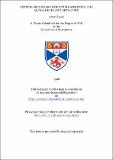Files in this item
Peptide secondary structure mimetics: The alpha-helix and beta-turn
Item metadata
| dc.contributor.advisor | Gani, D. (David) | |
| dc.contributor.author | Arwel, Lewis | |
| dc.coverage.spatial | 210 p. | en_US |
| dc.date.accessioned | 2018-07-16T14:31:01Z | |
| dc.date.available | 2018-07-16T14:31:01Z | |
| dc.date.issued | 1998 | |
| dc.identifier.uri | https://hdl.handle.net/10023/15433 | |
| dc.description.abstract | This thesis describes research undertaken in peptidomimetic chemistry, concerned with stabilisation of peptide secondary structure. The first section describes the successful synthesis of two triazepinediones for potential application as cis prolyl mimetics and/or β-turn mimetics. The first triazepinedione 64, carrying an N-phenyl substituent, was subjected to reductive conditions in an unsuccessful attempt to generate a cis prolyl peptide. The second triazepinedione 72 was designed as a Gly-cw Pro-Phe peptidomimetic. Its synthesis proceeded in 8 steps, via a chiral a-hydrazino acid. Triazepinedione 72 was extended from both the N and C termini, demonstrating that it could be incorporated into a peptide. The second section describes the design and attempted synthesis of an N-terminal template for stabilisation of a-helical structure in an attached peptide. Preliminary efforts to produce a Pro-Pro-Ala macrocycle 91 and a Pro-Pro-Pro ether macrocycle 98 were unsuccessful. Attempts to synthesise a Pro-Pro-Pro thioether macrocycle 112 resulted in formation of a cyclic dimer 122. The formation of this dimer was proposed to be due to excessive steric hindrance in the transition state to cyclisation. Attempts to stabilise the desired folded transition state by α-methylation of proline residues or hydrogen bonding did not allow synthesis of any of the desired monomeric cyclic material. A monomeric cyclic compound was finally obtained by increasing the flexibility of the linear precursor, affording a Pro-(2R)-Ala-Pro thioether macrocycle 151. X-Ray crystallography and 2D NMR studies established that this macrocycle lacked the required arrangement of carbonyl groups conducive to initiation of an α-helix. Further NMR studies of macrocycle-peptide conjugates suggested that the macrocycle exerted a conformational influence only over the first residue of the attached peptide. The carbonyl groups of the macrocycle were found to adopt a significant degree of α-helical geometry upon attachment of a C-terminal cationic trialkylammonium group. | en_US |
| dc.language.iso | en | en_US |
| dc.publisher | University of St Andrews | |
| dc.subject.lcc | QD431.3L3 | |
| dc.subject.lcsh | Peptides | en |
| dc.title | Peptide secondary structure mimetics: The alpha-helix and beta-turn | en_US |
| dc.type | Thesis | en_US |
| dc.contributor.sponsor | Wellcome Trust | en_US |
| dc.type.qualificationlevel | Doctoral | en_US |
| dc.type.qualificationname | PhD Doctor of Philosophy | en_US |
| dc.publisher.institution | The University of St Andrews | en_US |
This item appears in the following Collection(s)
Items in the St Andrews Research Repository are protected by copyright, with all rights reserved, unless otherwise indicated.

